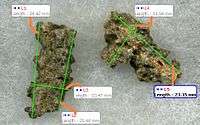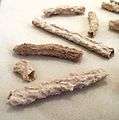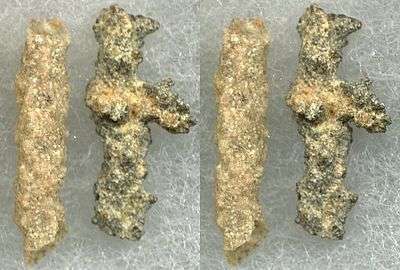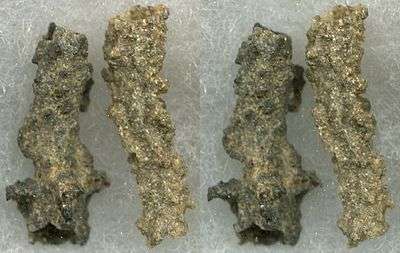Fulgurite

| Stereo image | ||
| ||
| ||
| ||
| ||
| Two Type I (arenaceous) fulgurites: a common tube fulgurite and a more irregular specimen. |
| Stereo image | ||
| ||
| ||
| ||
| ||
| Two small Type I Saharan Desert fulgurites.[1] In a planar view the specimen on the right has a blade-like morphology, but its tubular nature is dramatically shown in a stereo view. |

Fulgurites (from the Latin fulgur, meaning "lightning") are natural tubes, clumps, or masses of sintered, vitrified, and/or fused soil, sand, rock, organic debris and other sediments that can form when lightning discharges into ground. They can therefore be referred to as petrified lightning. They are classified as a variety of the mineraloid lechatelierite, although their absolute chemical composition is dependent on the physical and chemical properties of the usually granular-crystalline material providing an electrically and thermally conductive dissipation network for lightning-facilitated energy transfer. They are commonly hollow and/or branching assemblages of glassy, protocrystalline, and heterogeneously microcrystalline tubes, crusts, slags, vesicular masses, and clusters of refractory materials that often form during the discharge phase of lightning strikes propagating into silica-rich quartzose sand, mixed soil, clay, or other sediments.[2][3] Fulgurites are homologous to Lichtenberg figures, which are the branching patterns produced on surfaces of insulators during dielectric breakdown by high-voltage discharges, such as lightning.[4][5]
Description
Fulgurites are formed when lightning strikes the ground, fusing and vitrifying mineral grains.[6] Peak temperatures within a lightning channel are known to exceed 30,000 K, with sufficient pressure to produce planar deformation features, or "shock lamellae," in SiO2, a kind of polymorphism. This is also known colloquially as shocked quartz.[7][8][9] "Artificial fulgurites" can also be produced when the controlled arcing of electricity into an appropriate medium. Downed high voltage power lines have produced fulgurite-like lechatelierites, occasionally colored by copper from the power lines themselves.[10]
The primary SiO2 phase in common tube fulgurites is lechatelierite, a silica glass also found in impactites, but many other glasses may result from the processes involved with the production of fulgurites given their chemical context. Because their groundmass is generally amorphous in structure, fulgurites are classified as mineraloids.
The optical properties (color, surface texture modulation) of fulgurites vary widely, depending on bulk composition, refractory inclusions, interface dynamics, and chemical "impurities," among other possible sources of variation. Most natural fulgurites fall on a spectrum from colorless (transparent), to white, to black; moderate iron oxide content, among other factors, can result in a deep brownish-green coloration. More colorful variants are usually synthetic and reflect incorporation of synthetic materials. The interior of Type I (sand) fulgurites normally is very smooth or lined with fine bubbles, while other types are often both vesicular and dense, almost pore-free, or even scoria-like; their exteriors generally can be coated with rough sedimentary particles or small rocks and can be porous, smooth, or topologically-complex. Branching fulgurites display fractal-like self-similarity and structural scale invariance as a macroscopic or microscopic network of root-like branches, and can display this texture without central channels or obvious divergence from morphology of context or target (e.g. sheet-like melt, rock fulgurites). Fulgurites formed in sand or loose soil are mechanically fragile, making the field collection of large specimens difficult. Other fulgurite classes are often very durable and may withstand a long residence in the geologic record, an issue of some contention in planetary sciences, such as impact geology.
Fulgurites can exceed tens of centimeters in diameter and can penetrate deep into the subsoil, sometimes occurring as far as 15 m (49 ft) below the surface that was struck, but may form directly on appropriate sedimentary surfaces.[11] One of the longest fulgurites to have been found in modern times was a little over 4.9 m (16 ft) in length, and was found in northern Florida.[12] The Yale University Peabody Museum of Natural History displays one of the longest known preserved fulgurites, approximately 4 m (13 ft) in length.[13] Charles Darwin in The Voyage of the Beagle recorded that tubes such as these found in Drigg, Cumberland, UK reached a length of 9.1 m (30 ft).[14][15] The Winans Lake fulgurite[s] (Winans Lake, Livingston County, Michigan), extended discontinuously throughout a 30 m range, and arguably includes the largest reported fulgurite mass ever recovered and described - its largest section extending approximately 16 ft (4.88 m) in length by 1 ft in diameter (30 cm).[3][16]
Classification
Fulgurites have been classified by Pasek et al. (2012)[17] into five types related to the type of sediment in which the fulgurite formed, as follows:
- Type I - sand fulgurites with tubaceous structure; their central axial void may be collapsed
- Type II - soil fulgurites; these are glass-rich, and form in a wide range of sediment compositions, including clay-rich soils, silt-rich soils, gravel-rich soils, and loessoid; these may be tubaceous, branching, vesicular, irregular/slaggy, or may display a combination of these structures, and can produce exogenic fulgurites (droplet fulgurites)
- Type III - caliche or calcic sediment fulgurites, having thick, often surficially glazed granular walls with calcium-rich vitreous groundmass with little or no lechatelierite glass; their shapes are variable, with multiple narrow central channels common, and can span the entire range of morphological and structural variation for fulguritic objects
- Type IV - rock fulgurites, which are either crusts on minimally altered rocks, networks of tunneling within rocks, vesicular outgassed rocks (often glazed by a silicide-rich and/or metal oxide crust), or completely vitrified and dense rock material and masses of these forms with little sedimentary groundmass
- Type V - [droplet] fulgurites (exogenic fulgurites), which show evidence of ejection (e.g. spheroidal, botryoidal, filamentous, or aerodynamic),[2][18] related by composition to Type II and Type IV fulgurites
Significance
Paleoenvironmental indicator
The presence of fulgurites in an area can be used to predict the prevalence of lightning over the particular area over a certain period of time, which in turn can help in understanding the past climates, in the study of paleolightning.[1] For instance, the fact that fulgurites are abundant in the central Sahara Desert, where thunderstorm activity is very rare, demonstrates that thunderstorms were once more frequent in that region. As their spatial distributions guide reconstruction of convection and precipitation patterns, their bulk chemistry may lead to inferences about surface sediments and generally porous structures enclose and preserve samples of the ancient atmosphere in which they formed.[19]
Analysis of LIRM anomaly (see paleomagnetism) and reconstruction of ancient environmental conditions are motivations for the identification and study of fulgurites.[20].
Place in planetary processes and the geologic record
Many observations have been made in fulgurites of high-pressure, high-temperature materials more commonly assumed to be exclusive to meteoritic sources, products of asteroid impacts, comet airbursts, or cosmic dust. Such materials - as a suite - formerly considered to be unique to hypervelocity impacts, have been identified in fulgurites, including highly reduced silicon-metal alloys (silicides), the fullerene allotropes C60 (buckminsterfullerene) and C70, as well as high-pressure polymorphs of SiO2, collectively known as shocked quartz, in fulgurites.[3][7][16][21][22][23][24][25][26][27][28][29][30]
Reduced phosphorus as phosphides and phosphites has been identified through quantitative analyses of a representative sample of 10 fulgurites recovered from most continents, in the form of schreibersite (Fe3P, (Fe,Ni)3P) - otherwise extremely rare on Earth, but relatively common in meteorites, comets, interplanetary dust, and some planetary bodies - and TiP, which is unique to fulgurites, among other unusual compounds resulting from supercritical non-equilibrium.[3][31][32]
In material culture
A fulgurite was found within the contents of the ash altar at the temple of Lykaian Zeus at Mount Lykaion in Greece. It may be associated with ritual activity performed there.[33][34][35]
Fulgurites are appreciated by many for their value as tangible evidence of lightning strikes.[36] Fulgurites are also popular among hobbyists and collectors of natural specimens.[37]
Gallery
- Type I (sand) fulgurite, Okeechobee, Florida.
 Sand fulgurites, highly weathered (paleofulgurites) Algeria
Sand fulgurites, highly weathered (paleofulgurites) Algeria.jpg) Fulgurite, Mauritanian desert
Fulgurite, Mauritanian desert.jpg) Fulgurites, Mauritanian desert
Fulgurites, Mauritanian desert Fulgurites, Senne, Westphalia, Germany
Fulgurites, Senne, Westphalia, Germany- Tubaceous fulgurite, Iwamizawa, Japan
- Type II (soil, clastic) tubaceous fulgurite, Lancaster, California
See also
References
- 1 2 Sponholz, B.; Baumhauer, R.; Felix-Henningsen, P. (27 July 2016). "Fulgurites in the southern Central Sahara, Republic of Niger and their palaeoenvironmental significance". The Holocene. 3 (2): 97–104. doi:10.1177/095968369300300201.
- 1 2 Joseph, Michael L. (January 2012). "A Geochemical Analysis of Fulgurites: from the inner glass to the outer crust". Scholarcommons.usf.edu. Retrieved 2015-08-16.
- 1 2 3 4 "Fulgurite Classification, Petrology, and Implications for Planetary Processes - The University of Arizona Campus Repository". Arizona.openrepository.com. Retrieved 2015-08-16.
- ↑ "SGSMP : Lichtenberg figures". Sgsmp.ch. 2005-07-28. Archived from the original on 2015-08-02. Retrieved 2015-08-16.
- ↑ Ouellette, Jennifer (23 July 2013). "Fermilab Physicist Makes "Frozen Lightning" Art with Accelerators". Scientific American blog. Retrieved 11 August 2015.
- ↑ "Lightning Strike Fusion: Extreme Reduction and Metal-Silicate Liquid Immiscibility". Sciencemag.org. 1986-10-10. Retrieved 2015-08-16.
- 1 2 "Lightning-induced shock lamellae in quartz". Ammin.geoscienceworld.org. 2015-07-01. Retrieved 2015-08-16.
- ↑
- ↑
- ↑ http://agatelady.blogspot.com/2014/09/more-about-fulgurites.html. Missing or empty
|title=(help) - ↑ Ripley, George; Dana, Charles Anderson (1859). The New American Cyclopaedia. Appleton. p. 2.
- ↑ Grapes, R. H. (2006). Pyrometamorphism. Springer. p. 28. ISBN 3-540-29453-8.
- ↑ "New Peabody hall offering high-tech lessons about Earth and space". Yale Bulletin & Calendar. Yale University. 34 (30). June 9, 2006. Archived from the original on November 6, 2014. Retrieved 2013-12-26.
- ↑ "Presenting... Fulgurites". Oum.ox.ac.uk. Retrieved 2015-08-16.
- ↑ "The popular educator - Books on Google Play". Play.google.com. Retrieved 2015-08-16.
- 1 2 "Lightning strike fusion: extreme reduction and metal-silicate liquid immiscibility". Science-AAAS. 1986-10-10. Retrieved 2015-09-07.
- ↑ "Fulgurite morphology: a classification scheme and clues to formation - Springer". Contributions to Mineralogy and Petrology. Link.springer.com. 164: 477–492. 2012-04-24. Bibcode:2012CoMP..164..477P. doi:10.1007/s00410-012-0753-5. Retrieved 2015-08-16.
- ↑ "Fulgurite morphology: a classification scheme and clues to formation - Springer". Contributions to Mineralogy and Petrology. Link.springer.com. 164: 477–492. 2012-04-24. Bibcode:2012CoMP..164..477P. doi:10.1007/s00410-012-0753-5. Retrieved 2015-08-16.
- ↑ "Paleoecology reconstruction from trapped gases in a fulgurite from the late Pleistocene of the Libyan Desert" (PDF). Quest.nasa.gov. Archived from the original (PDF) on 2011-10-20. Retrieved 2015-08-16.
- ↑ Sponholz, B. (January 4–18, 2004). "Fulgurites as paleoclimatic indicators: New approaches on Holocene climatic change in the Sahara". First Joint Meeting of IGCP 490 and ICSU: Environmental Catastrophes in Mauritania, the Desert and the Coast.
- ↑ Daly, TK; Buseck, PR; Williams, P; Lewis, CF (2015-04-20). "Fullerenes from a fulgurite". Science. 259: 1599–601. Bibcode:1993Sci...259.1599D. doi:10.1126/science.259.5101.1599. PMID 17733026.
- ↑ Heymann, D. "Chemistry of Fullerenes on the Earth and in the Solar System : A 1995 Review" (PDF). LPS. Lpi.usra.edu. XXVII. Retrieved 2015-08-16.
- ↑ Macdonald, F.A.; Mitchell, K.; Cina, S.E. "Evidence for a Lightning-Strike Origin of the Edeowie Glass" (PDF). Lunar and Planetry Science. Lpi.usra.edu. XXXV. Retrieved 2015-08-16.
- ↑
- ↑ Carter, EA; Pasek, MA; Smith, T; Kee, TP; Hines, P; Edwards, HG (2015-04-20). "Rapid Raman mapping of a fulgurite". Anal Bioanal Chem. 397: 2647–58. doi:10.1007/s00216-010-3593-z. PMID 20229006.
- ↑ "A Raman spectroscopic study of a fulgurite | Philosophical Transactions of the Royal Society of London A: Mathematical, Physical and Engineering Sciences". Rsta.royalsocietypublishing.org. 2010-06-07. Retrieved 2015-08-16.
- ↑ Archived September 30, 2009, at the Wayback Machine.
- ↑ Sheffer, A.A.; Dyar, M.D.; Sklute, E.C. (2006). "Lightning Strike Glasses as an Analog for Impact Glasses" (PDF). Lunar and Planetry Science. Lpi.usra.edu. XXXVII. Retrieved 2015-08-16.
- ↑ Kochemasov, G.G. "Fulgurite" (PDF). Lunar and Planetry Science. Lpi.usra.edu. Retrieved 2015-08-16.
- ↑ Parnell, J.; Thackrey, S.; Muirhead, D.; Wright, A. "Transient High-Temperature Processing of Silicates in Fulgurites as Analogues for Meteorite and Impact Melts" (PDF). Lunar and Planetry Science. Lpi.usra.edu. XXXIX. Retrieved 2015-08-16.
- ↑ "Lightning-induced reduction of phosphorus oxidation state". Nature Geoscience. 2: 553–556. Bibcode:2009NatGe...2..553P. doi:10.1038/ngeo580. Retrieved 2015-08-16.
- ↑ Pasek, M.A.; Kee, T.P.; Carter, E.A.; Hargreaves, M.D.; H.G.M. Edwards; Z.Atlas (2010). "Fried Phosphate and Organic Survival : Lightning in Biogeochemical Cycles" (PDF). Astrobiology Sciences Conference. Lpi.usra.edu. Retrieved 2015-08-16.
- ↑ "Excavating at the Birthplace of Zeus* – Mt. Lykaion Excavation and Survey Project". Lykaionexcavation.org. 2003-07-20. Retrieved 2015-08-20.
- ↑ "Geochemical analysis of a Type II fulgurite" (PDF). lpi.usra.edu. Retrieved 2015-08-19.
- ↑ "Fulgurite Classification, Petrology, and Implications for Planetary Processes" (abstract, link to PDF full text). arizona.openrepository.com. Retrieved 2015-08-19.
- ↑ Chambers's journal By William Chambers, Robert Chambers
- ↑ Patti Polk, Collecting Rocks, Gems & Minerals: Easy Identification - Values - Lapidary Uses, Krause, 2010, page 168 ISBN 978-1-4402-0415-9
External links
| Wikimedia Commons has media related to Fulgurites. |

- The Bibliography of Fulgurites
- H. J. Melosh, Impact geologists, beware! Geophysical Research Letters, Volume44, Issue17, Pages 8873-8874, 2017
- Petrified Lightning by Peter E. Viemeister (pdf)
- Interview (The Event: Petrified Lightning from Central Florida) with artist Allan McCollum along with an historical archive of sixty-six
- Mindat with location data
- W. M. Myers and Albert B. Peck, A Fulgurite from South Amboy, New Jersey, American Mineralogist, Volume 10, pages 152-155, 1925
- Vladimir A. Rakov, Lightning Makes Glass, 29th Annual Conference of the Glass Art Society, Tampa, Florida, 1999

